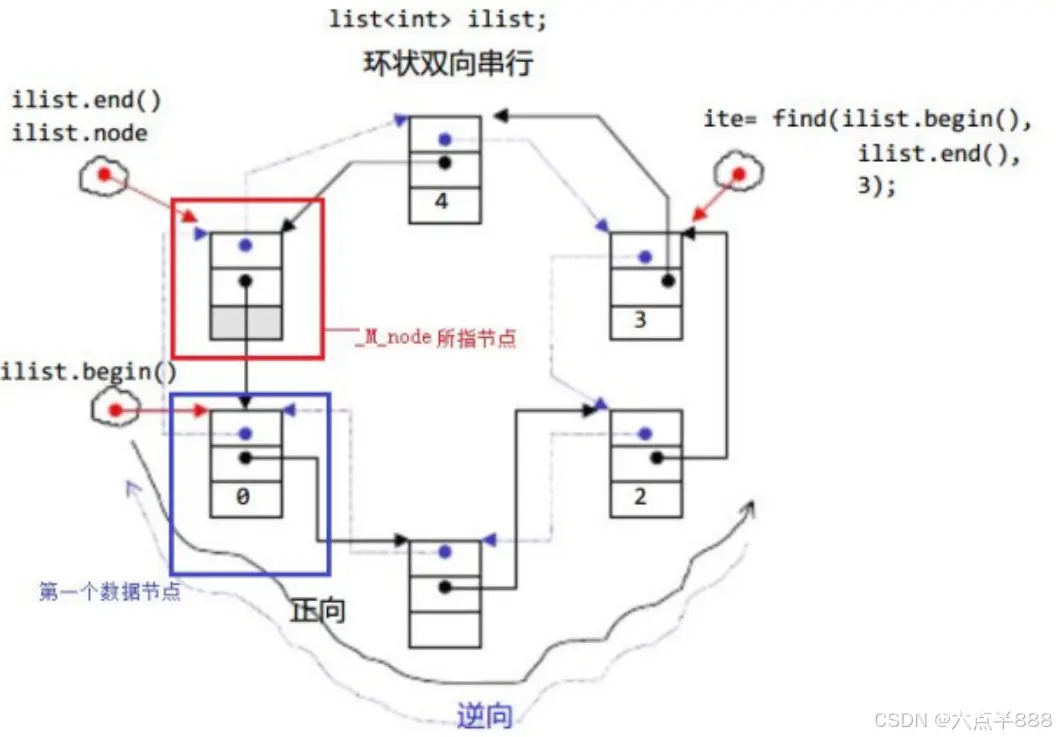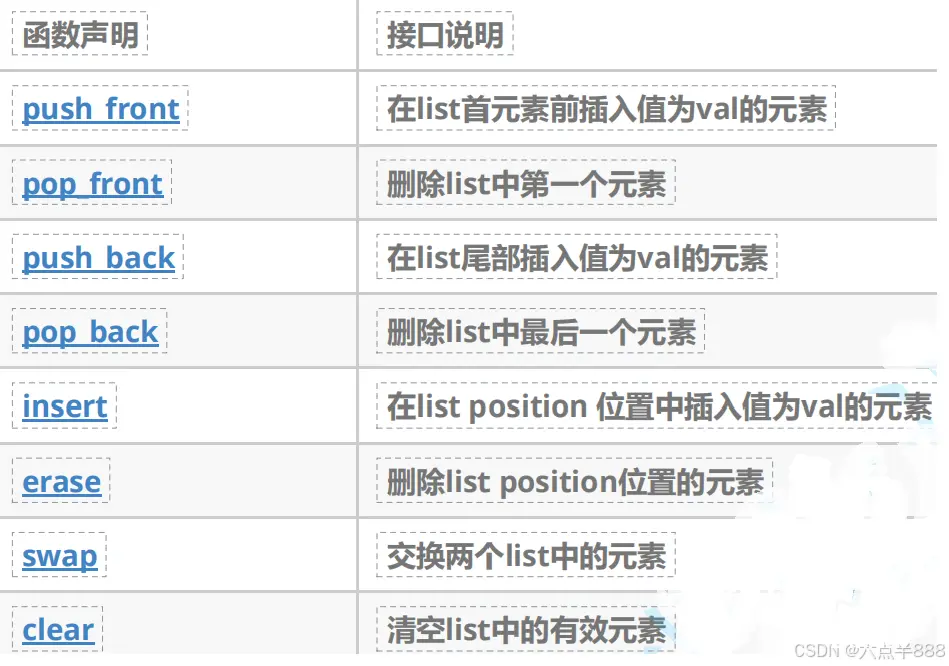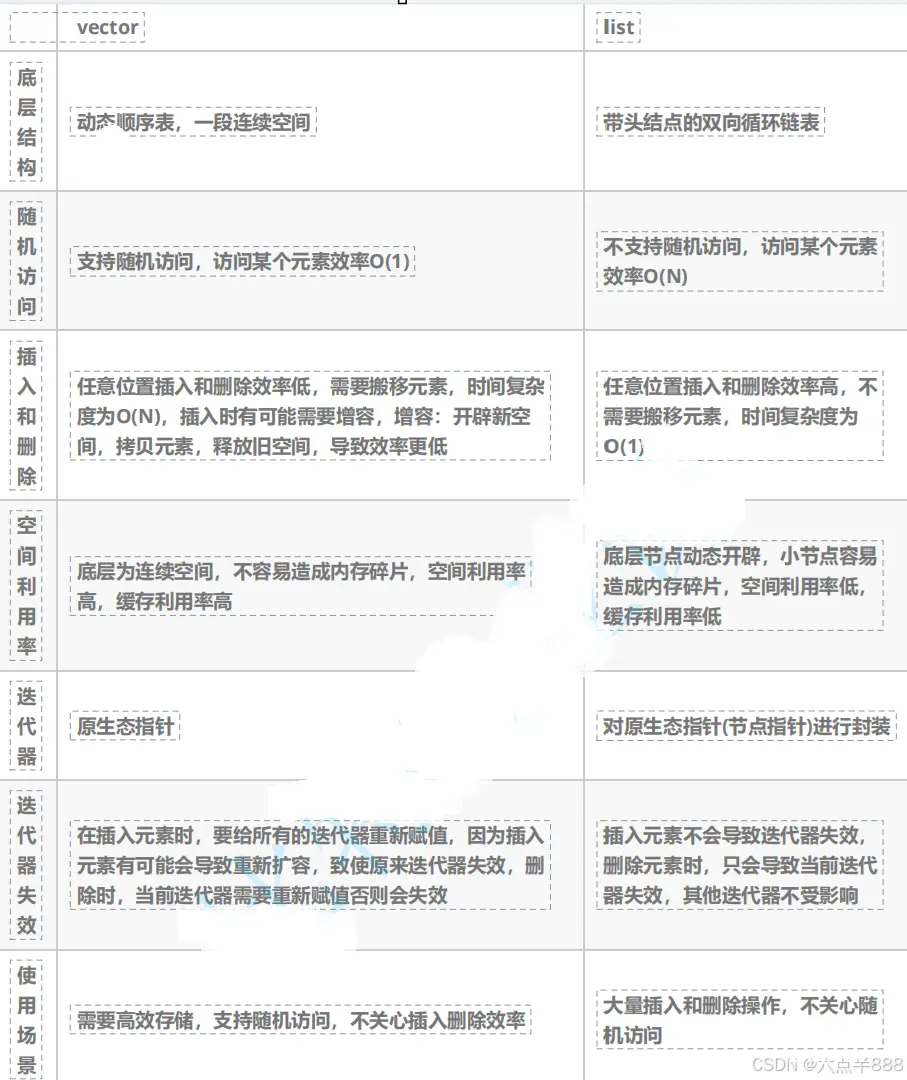【C++】“list”的介绍和常用接口的模拟实现
六点半888 2024-10-07 10:35:01 阅读 73
【C++】“list”的介绍和常用接口的模拟实现
一. list的介绍1. list常见的重要接口2. list的迭代器失效
二. list常用接口的模拟实现(含注释)三. list与vector的对比
一. list的介绍
list是可以在常数范围内在任意位置进行插入和删除的序列式容器,并且该容器可以前后双向迭代。list的底层是双向带头链表结构,双向链表中每个元素存储在互不相关的独立节点中,在节点中通过指针指向其前一个元素和后一个元素。list与forward_list非常相似:最主要的不同在于forward_list是单链表,只能朝前迭代,已让其更简单高效。与其他的序列式容器相比(array,vector,deque),list通常在任意位置进行插入、移除元素的执行效率更好。与其他序列式容器相比,list和forward_list最大的缺陷是不支持任意位置的随机访问,比如:要访问list的第6个元素,必须从已知的位置(比如头部或者尾部)迭代到该位置,在这段位置上迭代需要线性的时间开销;list还需要一些额外的空间,以保存每个节点的相关联信息。

1. list常见的重要接口


begin与end为正向迭代器,对迭代器执行++操作,迭代器向后移动rbegin(end)与rend(begin)为反向迭代器,对迭代器执行++操作,迭代器向前移动

2. list的迭代器失效
迭代器失效即迭代器所指向的节点的无效,即该节点被删除了。因为list的底层结构为带头结点的双向循环链表,因此在list中进行插入时是不会导致list的迭代器失效的,只有在删除时才会失效,并且失效的只是指向被删除节点的迭代器,其他迭代器不会受到影响
二. list常用接口的模拟实现(含注释)
<code>#include<assert.h>
#include<iostream>
using std::cout;
using std::endl;
namespace wch
{ -- -->
//由于list中的val支持多种类型,定义模板参数T
template<class T>
struct list_node
{
list_node<T>* _next;
list_node<T>* _prev;
T _val;
//T(),针对自定义类型会去调用它的构造函数,针对内置类型无影响
list_node(const T& val = T())
:_next(nullptr)
, _prev(nullptr)
, _val(val)
{ }
};
// typedef __list_iterator<T, T&, T*> iterator;
// typedef __list_iterator<T, const T&, const T*> const_iterator;
//此处定义多个模板参数针对返回值类型
template<class T, class Ref, class Ptr>
struct __list_iterator
{
typedef list_node<T> Node;
typedef __list_iterator<T, Ref, Ptr> self;
Node* _node;
__list_iterator(Node* node)
:_node(node)
{ }
Ref operator*() const//重载普通对象解引用
{
return _node->_val;
}
Ptr operator->() const//重载指针对象解引用
{
return &_node->_val;
}
self& operator++()//返回对象在函数体执行结束后依旧存在,建议引用返回,减少拷贝开销
{
_node = _node->_next;
return *this;
}
//返回对象(局部变量或指向局部变量的指针)在函数体执行结束后不存在,不可引用返回,值返回
self operator++(int)
{
self tmp(*this);
_node = _node->_next;
return tmp;
}
self& operator--()
{
_node = _node->_prev;
return *this;
}
self operator--(int)
{
self tmp(*this);
_node = _node->_prev;
return tmp;
}
//尽量使用引用形参, 避免拷贝开销。同时在不需要修改实参时,通过指定const 引用形参来限制。
bool operator!=(const self& it) const
{
return _node != it._node;
}
bool operator==(const self& it) const
{
return _node == it._node;
}
};
template<class T>
class list
{
typedef list_node<T> Node;
public:
typedef __list_iterator<T, T&, T*> iterator;
typedef __list_iterator<T, const T&, const T*> const_iterator;
// 这样设计const迭代器是不行的,因为const迭代器期望指向内容不能修改
// 这样设计是迭代器本身不能修改
// T* const ptr2;
iterator begin()
{
//return _head->_next;//单参构造函数支持隐式类型转换
return iterator(_head->_next);
}
iterator end()
{
return _head;//单参构造函数支持隐式类型转换
//return iterator(_head);
}
const_iterator begin() const
{
//return _head->_next;
return const_iterator(_head->_next);
}
const_iterator end() const
{
return _head;
//return const_iterator(_head);
}
void empty_init()
{
_head = new Node;
_head->_prev = _head;
_head->_next = _head;
_size = 0;
}
list()//无参默认构造函数
{
empty_init();
}
// lt2(lt1)
list(const list<T>& lt)//拷贝构造
//list(const list& lt)//不加类型也可以,不建议
{
empty_init();
for (auto& e : lt)//深拷贝
{
push_back(e);
}
}
void swap(list<T>& lt)
{
std::swap(_head, lt._head);
std::swap(_size, lt._size);
}
list<T>& operator=(list<T> lt)//赋值运算符重载
//list& operator=(list lt)//不加类型也可以,不建议
{
swap(lt);
return *this;
}
~list()//析构函数
{
clear();
delete _head;
_head = nullptr;
}
void clear()
{
iterator it = begin();
while (it != end())
{
it = erase(it);//带位置返回值的erase函数,防止迭代器失效
}
_size = 0;
}
void push_back(const T& x)
{
insert(end(), x);
}
void push_front(const T& x)
{
insert(begin(), x);
}
void pop_back()
{
erase(--end());
}
void pop_front()
{
erase(begin());
}
// pos位置之前插入
iterator insert(iterator pos, const T& x)
{
Node* cur = pos._node;
Node* prev = cur->_prev;
Node* newnode = new Node(x);
prev->_next = newnode;
newnode->_next = cur;
cur->_prev = newnode;
newnode->_prev = prev;
++_size;
return newnode;
}
//删除pos处节点
iterator erase(iterator pos)
{
assert(pos != end());//不可删除头节点
Node* cur = pos._node;
Node* prev = cur->_prev;
Node* next = cur->_next;
prev->_next = next;
next->_prev = prev;
delete cur;
--_size;
return next;
}
size_t size()
{
/*size_t sz = 0;
iterator it = begin();
while (it != end())
{
++sz;
++it;
}
return sz;*/
return _size;
}
private:
Node* _head;
size_t _size;
};
void Print(const list<int>& lt)
{
list<int>::const_iterator it = lt.begin();
while (it != lt.end())
{
//(*it) += 1;
cout << *it << " ";
++it;
}
cout << endl;
}
void test_list1()
{
list<int> lt;
lt.push_back(1);
lt.push_back(2);
lt.push_back(3);
lt.push_back(4);
list<int>::iterator it = lt.begin();
//由于链表的各个节点地址是不连续的,前一个节点的地址可能比后一个地址大,所以不可已写为 it < it.end();
while (it != lt.end())
{
(*it) += 1;
cout << *it << " ";
++it;
}
cout << endl;
for (auto e : lt)
{
cout << e << " ";
}
cout << endl;
Print(lt);
}
struct A
{
A(int a1 = 0, int a2 = 0)
:_a1(a1)
, _a2(a2)
{ }
int _a1;
int _a2;
};
void test_list2()
{
list<A> lt;
lt.push_back(A(1, 1));
lt.push_back(A(2, 2));
lt.push_back(A(3, 3));
lt.push_back(A(4, 4));
list<A>::iterator it = lt.begin();
while (it != lt.end())
{
//cout << (*it)._a1 << " " << (*it)._a2 << endl;
//it->->_a1, it->->_a2,特殊处理为一个->
cout << it->_a1 << " " << it->_a2 << endl;
++it;
}
cout << endl;
}
void test_list3()
{
list<int> lt;
lt.push_back(1);
lt.push_back(2);
lt.push_back(3);
lt.push_back(4);
lt.push_front(5);
lt.push_front(6);
lt.push_front(7);
lt.push_front(8);
for (auto e : lt)
{
cout << e << " ";
}
cout << endl;
lt.pop_front();
lt.pop_back();
for (auto e : lt)
{
cout << e << " ";
}
cout << endl;
lt.clear();
lt.push_back(10);
lt.push_back(20);
lt.push_back(30);
lt.push_back(40);
for (auto e : lt)
{
cout << e << " ";
}
cout << endl;
cout << lt.size() << endl;
}
void test_list4()
{
list<int> lt;
lt.push_back(1);
lt.push_back(2);
lt.push_back(3);
lt.push_back(4);
for (auto e : lt)
{
cout << e << " ";
}
cout << endl;
list<int> lt1(lt);
for (auto e : lt1)
{
cout << e << " ";
}
cout << endl;
list<int> lt2;
lt2.push_back(5);
lt2.push_back(6);
lt2.push_back(7);
lt2.push_back(8);
for (auto e : lt2)
{
cout << e << " ";
}
cout << endl;
lt1 = lt2;
for (auto e : lt1)
{
cout << e << " ";
}
cout << endl;
}
}
三. list与vector的对比
vector与list都是STL中非常重要的序列式容器,由于两个容器的底层结构不同,导致其特性以及应用场景不同,其主要不同如下:

声明
本文内容仅代表作者观点,或转载于其他网站,本站不以此文作为商业用途
如有涉及侵权,请联系本站进行删除
转载本站原创文章,请注明来源及作者。